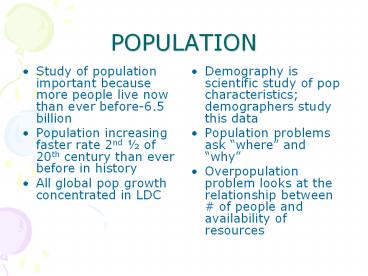POPULATION - PowerPoint PPT Presentation
Title:
POPULATION
Description:
POPULATION Study of population important because more people live now than ever before-6.5 billion Population increasing faster rate 2nd of 20th century than ever ... – PowerPoint PPT presentation
Number of Views:199
Avg rating:3.0/5.0
Title: POPULATION
1
POPULATION
- Study of population important because more people
live now than ever before-6.5 billion - Population increasing faster rate 2nd ½ of 20th
century than ever before in history - All global pop growth concentrated in LDC
- Demography is scientific study of pop
characteristics demographers study this data - Population problems ask where and why
- Overpopulation problem looks at the relationship
between of people and availability of resources
2
Where is the Worlds Population Distributed?
- Population Concentrations-2/3 live in East Asia,
South Asia, SE Asia, western Europe - Clustering is shown on cartograms see figure 2-1
- 4 regions have similarities
- people live near ocean or river
- generally low-lying area with fertile soil
temperate climate - all located in Northern Hemisphere (10-55 degrees
north latitude) except for SE Asia
3
East Asia
- 1/5 worlds people live in East Asia
- 5/6 of people in this concentration live in
Peoples Republic of China - worlds most populous country 3rd largest land
area-near Pacific coast fertile river
valleys-Huang Yangtze
- 26 urban areas with more than 2 million people,
but 2/3 of people live in rural areas-farmers - Japan South Korea pop not distributed evenly
- 1/3 people live in 3 metropolitan areas-Tokyo,
Osaka, Seoul - ¾ Japanese and Koreans live urban
areas-industrial or service jobs rather than
farmers unlike China
4
South Asia Southeast Asia
- 1/5 worlds people live in South Asia-India,
Pakistan, Bangladesh, Sri Lanka (island) - most people in India live along plains of Indus
and Ganges rivers also concentrated near 2
coastlines-Arabian Sea-west Bay of Bengal-east - most people live rural areas farmers
- 4th largest pop cluster ½ billion people live on
series of islands between Indian Pacific Oceans
(includes Java, Sumatra, Borneo, Papua New
Guinea, Philippines - Java-100 million people
- Indonesia (which includes Java) 4th most populous
country - most people-rural areas-farmers
5
Europe Other Pop Clusters
- 1/9 of worlds people from Europe (including
European portion of Russia) - ¾ inhabitants live in cities less than 20
farmers - Dense network of road and rail links people
- Region has temperate climate
- Have to import food resources
- largest concentration in Western Hemisphere in
northeastern U.S. - urban areas-less than 5 farmers
- 2 of worlds population in West Africa Nigeria
most populous country - people work in agriculture
6
Sparsely Populated Regions
- Ecumene refers to the portion of Earths surface
occupied by permanent human settlement - ¾ of worlds population live on only 5 of
Earths surface
7
Dry Lands
- 20 of Earths land surface is too dry for
farming - Northern Hemisphere-Sahara, Arabian, Thar, Takla
Makan, Gobi - Southern Hemisphere-most of Australia
- lack sufficient water to feed a population
- people are able to live and raise animals in
desert (nomads) - Some desert areas contain natural resources i.e.
oil reserves which leads to settlement in these
areas
8
Wet Lands
- Land that receives too much rainfall makes human
occupation difficult (areas around equator) - Combination of rain heat rapidly depletes
nutrients from soil (leaching)
- Certain areas that do receive extra rainfall i.e.
Southeast Asia are able to produce enough food to
support their population (rice)
9
Cold Lands High Lands
- land near North and South Poles is constantly
covered with ice or ground is permanently frozen
(permafrost) - area unsuitable for planting crops
- few people can live at high elevations-sparsely
populated - Exceptions are higher elevations in Latin America
and Africa where people have settled - Mexico City-7,360
10
Population Density
- Arithmetic Density-total people divided by
total land area (aka population density) - U.S.-78 per sq. mile, Bangladesh-2,640 per square
mile, Canada-7 per square mile, India-840 per
square mile
- Physiological Density-number of people supported
by unit area of arable (farmable) land - Large difference in physiological density
demonstrates how much more some countries arable
land must yield to support their population
11
Agricultural Density
- Term refers to the ratio of the number of farmers
to the amount of arable land - For example, U.S. has a low agricultural density
at 4 farmers per square km of arable land
- Egypt on the other hand has a higher agricultural
density at 1,401 farmers per square km - Typically MDC have lower agricultural density
because of technology and finances
12
Where Has the Worlds Population Increased?
- Geographers measure population change in a
country of the world thru 3 measures - Crude Birth Rate (CBR)-total of live births in
a year for every 1,000 people - Crude Death Rate (CDR)-total of deaths in a
year for every 1,000 people alive in that society - Natural Increase Rate (NIR)- by which a
population grows in a year. Subtract CBR from
CDR (see page 53)
13
Natural Increase































